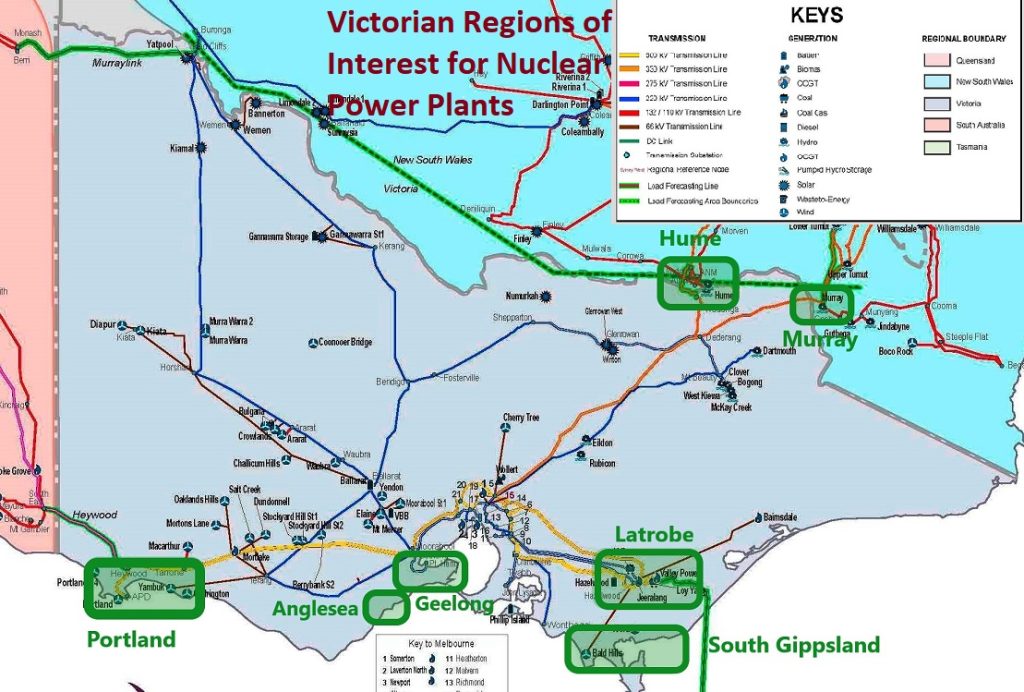
Victorian Nuclear Power Plant locations
Edition 5, Revised 28/02/2025
Locations for Nuclear Power Plants in Victoria
The Nuclear For Climate “Optimum Plan” for the NEM calls for 18GW of nuclear capacity in 2050 and 30GW by 2060. Based on existing demand the Victorian proportion is about 24% of this requiring 4.8GW in 2050 and 7.6GW by 2060.
In Victoria this could be achieved by a fleet of large nuclear power plants though depending on available water resources some inland sites may be more suited to small plants or SMR’s which have less than 300MW capacity. Fortunately the Latrobe has a unique ability to use the existing brown coal pits at Yallourn, Hazelwood and Loy Yang as large cooling ponds. They would be rechaged by ground water and surface water and have a much lower water use than traditional evaporative cooling towers.
By 2050, four large 1.2 GW, AP 1000 plants would provide 4.8 GW of capacity. This would increase to six large plants and two small plants by 2060 to provide7.77GW. Large plants have pluses and minuses.
While large plants are lower cost per unit of capacity than small plants, they all need to be built in multiples at each site to achieve their greatest economies. For large plants this means the minimum actual installed capacity at a site would be 2.4GW
To build 4.8GW of new nuclear by 2050 (and 7.77GW by 2060) will require construction of large plants at both inland and coastal locations. Coastal sites will require a modest increase in transmission capacity to convey the energy through to the major load centres.
In the following image and tabulations we have included locations and suggested capacities for nuclear power plants at each site.
The first Table 1 assumes that cooling resources will be available at these sites to meet the long term needs of the plants. Table 2 assumes greater constrains on cooling water availability which results in an increased number of small 300MW plants at a greater number of sites. May options and combinations are available.
Table 1 Plant Locations and cooling type
| Location |
2050 |
2060 |
|||
| Capacity MW | Number of Units | Capacity MW | Number of Units | Cooling Type | |
| Latrobe Valley | 4,800 | 4 | 4,800 | 4 | Cooling Ponds |
| Cape Patterson | 0 | 0 | 2,400 | 2 | Seawater |
| Portland | 0 | 0 | 570 | 2 | Seawater |
| Total | 4,800 | 4 | 7,770 | 8 | |
 Locations for these plants have been chosen using the criteria listed in Site Selection
Locations for these plants have been chosen using the criteria listed in Site Selection
Victoria and the National Grid
Transmission and distribution currently make up the largest share of our electricity bills. In Victoria its of the order of 45% while in SA its around 68%. Our analysis shows that going to 100% renewable energy with wind and solar could see this component at least double in cost.
Using nuclear power plants we can make huge saving on the most expensive part of our electricity bills.
In Victoria sites such as those in the old coal plants in the Latrobe Valley can readily be switched over to four new nuclear power plants. Upgrades to the transfer capacity between the states such as VNI-minor, Marinus Link, VNI – West, Hume Link and Energy connect will provide a robust network capable of supplying power to Victoria in the rare event og a single nuclear power unit going off line.
A very detailed discussion of the challenges being faced by countries integrating different forms of energy generation onto their grids can be found at: Electricity Transmission Grids – World Nuclear Association
Cooling Victorian Nuclear Plants
The existing brown coal pits at Loy Yang, Yallourn and Hazelwood are immense both in terms of volume and surface area. Approximate volumes and areas if used for pit cooling and water storage appear in Table 1.
One common means of cooling inland coal or nuclear power plants is through the use of evaporative cooling towers as is currently done at Loy Yang and Yallourn and many other coal fired plants in Australia. Future nuclear power plants constructed in the Latrobe Valley could use this same method by using surface water and ground water from the natural environment.
Another option is the use of cooling ponds. These are used in Australia and internationally for both coal and nuclear thermal power plants. A notable example was Liddell Power Station in NSW where a 2,000 MW coal plant used the 11 square kilometre Lake Liddell both for surface cooling Liddell and also for drought proofing the Liddell and the 2,640 MW Bayswater coal fired power plants.
As a guide to performance, Lake Liddell provides a cooling surface area of 5.5m2/kW for the 2000 MW Liddell coal plant. In comparison, the coal mine pits in the Latrobe would provide a more conservative capacity of 6.6m2/kW for 4,400MW of nuclear power.
| Plant | Capacity MW | Pond Area km2 | m2/kW | Pond Volume millions m3 |
| Liddell NSW | 2000 | 10.99 | 5.5 | |
| Loy Yang | ||||
| Existing | 5.1 | 224 | ||
| Future | 3.65 | 160 | ||
| Yallourn | 6.94 | 95 | ||
| Hazelwood | ||||
| Pond 1 existing to RL 77 Assume 7m | 3.9 | 27 | ||
| Pit Re-use to RL 54 | 9.44 | 293 | ||
| Total Nuclear | 4,800 | 29.03 | 6.05 | Say 800 |
Table 1 Pond Capacities in the Latrobe Valley
Cooling ponds have lower evaporative losses than cooling towers but if not existing require considerably greater capital expenditure. A cooling pond transfers a larger percentage of waste heat to the atmosphere via convection and less by evaporation because of the lower differential temperature between the water and the air, reducing the rate of evaporation and thus the rate of water loss relative to cooling towers. Their environmental impacts are typically less than direct cooling. This would be a very suitable option for nuclear power plants located in the Latrobe Valley where the disused coal pits can be re-used as cooling ponds.
If it was decided to use cooling towers then the huge stored volume of water in the ponds would drought proof the nuclear plants. From Table 1, about 800 million cubic metres of water would be held in the ponds of which about 50% would come from ground water infiltration based on assumptions made in the Hazelwood Power station rehabilitation plans. This equates to some 50 years of storage for a 1GW nuclear power plant if using an evaporative cooling solution or 12 years for four typical 1.1 GW nuclear power plants.
The following three images show the cooling ponds constructed adjacent to the existing and demolished coal fired plants. To use the full capacity of these ponds, they would be interconnected by pipelines for water transfer. An additional benefit is provided longer term by filling the ponds with water to maintain the slope stability of the existing excavations. This would significantly reduce the costs of pit rehabilitation.
In conclusion, the existing brown coal pits in the Latrobe offer a significant asset that can provide cooling for significant amounts of ultra-low carbon nuclear generated electricity. This will apply whether cooling ponds or cooling towers are used.
An excellent and detailed outline of the cooling options is available at: Cooling Power Plants | Power Plant Water Use for Cooling – World Nuclear Association
